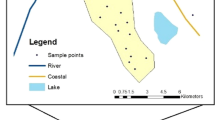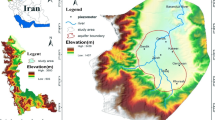Abstract
Considering the great importance of groundwater quality for water supply, in the last decade, significant scientific attention has been devoted to nitrate reduction transformation pathways and nitrogen conservation in groundwaters in the form of ammonium. To evaluate and assess the ability of machine learning models to predict the ammonium concentration, four machine learning models were applied: a three-layer neural network (NN), a deep neural network (DNN), and two variants of support vector regression (SVR) models: with linear and with Gaussian radial basis function kernel. A dataset of 322 samples with 13 predictor variables representing selected parameters responsible for oxidative/reductive nitrogen transformations in shallow alluvial groundwater was acquired from measurements in 55 monitoring wells during a 6-year monitoring period (2011–2016) in Serbia. Applied principal component analysis and cluster analysis gave an insight into conditionality and relations between the selected parameters, distinguishing four main factors, which explained 70.97% of total variance, and classifying examined objects by similarity. Extracted factors correlated the concentration patterns, implying the main nitrogen transformations in examined groundwater. The machine learning models were successfully applied for predicting the ammonium concentration with high determination coefficients (R2) in tests: 0.84 for DNN and 0.64 for NN, while the SVR did not prove to be adequate with the best R2 of 0.24.







Similar content being viewed by others
References
Ostad-Ali-Askari, K., Shayannejad, M., & Ghorbanizadeh-Kharazi, H. (2017). Artificial neural network for modeling nitrate pollution of groundwater in marginal area of Zayandeh-Rood River, Isfahan, Iran. KSCE Journal of Civil Engineering, 21(1), 134–140.
Nikolenko, O., Jurado, A., Borges, A. V., Knӧller, K., & Brouyѐre, S. (2018). Isotopic composition of nitrogen species in groundwater under agricultural areas: a review. Science of the Total Environment, 621, 1415–1432.
Ingested nitrate and nitrite, and cyanobacterial peptide toxins. (2010). IARC Monographs on the Evaluation of Carcinogenic Risks to Humans, 94.
Camargo, J. A., & Alonso, Á. (2006). Ecological and toxicological effects of inorganic nitrogen pollution in aquatic ecosystems: a global assessment. Environment International, 32(6), 831–849.
Pesticide Safety Education Program (PSEP). (2018). Nitrate: health effects in drinking water. Retrieved from http://psep.cce.cornell.edu/facts-slides-self/facts/nit-heef-grw85.aspx
Burgin, A. J., & Hamilton, S. K. (2007). Have we overemphasized the role of denitrification in aquatic ecosystems? A review of nitrate removal pathways. Frontiers in Ecology and the Environment, 5(2), 89–96.
Dimkic, M., Brauch, H.-J., & Kavanaugh, M. (2008). Groundwater management in large river basins. IWA Publishing.
Rivett, M. O., Buss, S. R., Morgan, P., Smith, J. W. N., & Bemment, C. D. (2008). Nitrate attenuation in groundwater: a review of biogeochemical controlling processes. Water Research, 42(16), 4215–4232.
Perović, M., Obradović, V., Kovačević, S., Mitrinović, D., Živančev, N., & Nenin, T. (2017). Indicators of groundwater potential for nitrate transformation in a reductive environment. Water Environment Research, 89(1), 4–16.
Korom, S. F. (1992). Natural denitrification in the saturated zone: a review. Water Resources Research, 28(6), 1657–1668.
Kelso, B., Smith, R. V., Laughlin, R. J., & Lennox, S. D. (1997). Dissimilatory nitrate reduction in anaerobic sediments leading to river nitrite accumulation. Applied and Environmental Microbiology, 63(12), 4679–4685.
Henson, W. R., Huang, L., Graham, W. D., & Ogram, A. (2017). Nitrate reduction mechanisms and rates in an unconfined eogenetic karst aquifer in two sites with different redox potential. Journal of Geophysical Research: Biogeosciences, 122(5), 1062–1077.
Rice, C. W., & Tiedje, J. M. (1989). Regulation of nitrate assimilation by ammonium in soils and in isolated soil microorganisms. Soil Biology and Biochemistry, 21(4), 597–602.
Heffernan, J. B., Cohen, M. J., Frazer, T. K., Thomas, R. G., Rayfield, T. J., Gulley, J., Martin, J. B., Delfino, J. J., & Graham, W. D. (2010). Hydrologic and biotic influences on nitrate removal in a subtropical spring-fed river. Limnology and Oceanography, 55(1), 249–263.
Cohen, M. J., Heffernan, J. B., Albertin, A., & Martin, J. B. (2012). Inference of riverine nitrogen processing from longitudinal and diel variation in dual nitrate isotopes. Journal of Geophysical Research: Biogeosciences, 117(G1).
Chapelle, F. H. (2000). Ground-water microbiology and geochemistry. John Wiley & Sons.
Oshiki, M., Ishii, S., Yoshida, K., Fujii, N., Ishiguro, M., Satoh, H., & Okabe, S. (2013). Nitrate-dependent ferrous iron oxidation by anaerobic ammonium oxidation (anammox) bacteria. Applied and Environmental Microbiology, 79(13), 4087–4093.
Davidson, E. A., Chorover, J., & Dail, D. B. (2003). A mechanism of abiotic immobilization of nitrate in forest ecosystems: the ferrous wheel hypothesis. Global Change Biology, 9(2), 228–236.
Institute for Develpoment of Water Resources Jaroslav Černi, Belgrade. Government of Republic of Serbia. Ministry of Agriculture and Environmental Protection. (2015). (In Serbian) Water Management Strategy, (WMS). Retrieved from http://www.rdvode.gov.rs/doc/Strategija_FINAL.pdf
European Environmental Agency, Corine Land Cover (CLC) 2006, Dataset. (2006). Retrieved May 20, 2020, from https://land.copernicus.eu/pan-european/corine-land-cover/clc-2006/view
Republic office for statistics (RZS). (2016). (in Serbian) Statistički godišnjak Republike Srbije.
Singh, C. K., Kumar, A., & Bindal, S. (2018). Arsenic contamination in Rapti River Basin, Terai region of India. Journal of Geochemical Exploration, 192, 120–131.
Postma, D., Boesen, C., Kristiansen, H., & Larsen, F. (1991). Nitrate reduction in an unconfined sandy aquifer: water chemistry, reduction processes, and geochemical modeling. Water Resources Research, 27(8), 2027–2045.
Darwishe, H., El Khattabi, J., Chaaban, F., Louche, B., Masson, E., & Carlier, E. (2017). Prediction and control of nitrate concentrations in groundwater by implementing a model based on GIS and artificial neural networks (ANN). Environmental Earth Sciences, 76(19), 649.
Verma, S., & Mukherjee, A. (2018). Groundwater quality, contamination, and processes in Brahmaputra River basin aquifers. In Groundwater of South Asia (pp. 291–305). Springer.
Hyer, K. E. (2007). A multiple-tracer approach for identifying sewage sources to an urban stream system. Geological Survey (US).
Xue, D., Botte, J., De Baets, B., Accoe, F., Nestler, A., Taylor, P., et al. (2009). Present limitations and future prospects of stable isotope methods for nitrate source identification in surface-and groundwater. Water Research, 43(5), 1159–1170.
Gasser, G., Pankratov, I., Elhanany, S., Glazman, H., & Lev, O. (2014). Calculation of wastewater effluent leakage to pristine water sources by the weighted average of multiple tracer approach. Water Resources Research, 50(5), 4269–4282.
Ellis, B., & Bertrand-Krajewski, J.-L. (2010). Assessing infiltration and exfiltration on the performance of urban sewer systems. IWA Publishing.
Rail, C. D. (2000). Groundwater contamination, volume I: sources and hydrology. CRC Press.
Nolan, B. T., Fienen, M. N., & Lorenz, D. L. (2015). A statistical learning framework for groundwater nitrate models of the Central Valley, California, USA. Journal of Hydrology, 531, 902–911.
Shrestha, S., & Kazama, F. (2007). Assessment of surface water quality using multivariate statistical techniques: a case study of the Fuji river basin, Japan. Environmental Modelling & Software, 22(4), 464–475.
Almasri, M. N., & Kaluarachchi, J. J. (2005). Modular neural networks to predict the nitrate distribution in ground water using the on-ground nitrogen loading and recharge data. Environmental Modelling & Software, 20(7), 851–871.
Wang, M. X., Liu, G. D., Wu, W. L., Bao, Y. H., & Liu, W. N. (2006). Prediction of agriculture derived groundwater nitrate distribution in North China Plain with GIS-based BPNN. Environmental Geology, 50(5), 637–644.
Yesilnacar, M. I., Sahinkaya, E., Naz, M., & Ozkaya, B. (2008). Neural network prediction of nitrate in groundwater of Harran Plain, Turkey. Environmental Geology, 56(1), 19–25.
Ransom, K. M., Nolan, B. T., Traum, J. A., Faunt, C. C., Bell, A. M., Gronberg, J. A. M., et al. (2017). A hybrid machine learning model to predict and visualize nitrate concentration throughout the Central Valley aquifer, California, USA. Science of the Total Environment, 601, 1160–1172.
Isazadeh, M., Biazar, S. M., & Ashrafzadeh, A. (2017). Support vector machines and feed-forward neural networks for spatial modeling of groundwater qualitative parameters. Environmental Earth Sciences, 76(17), 610.
Khalil, A., Almasri, M. N., McKee, M., & Kaluarachchi, J. J. (2005). Applicability of statistical learning algorithms in groundwater quality modeling. Water Resources Research, 41(5).
Arabgol, R., Sartaj, M., & Asghari, K. (2016). Predicting nitrate concentration and its spatial distribution in groundwater resources using support vector machines (SVMs) model. Environmental Modeling & Assessment, 21(1), 71–82.
Sousa, S. I. V., Martins, F. G., Alvim-Ferraz, M. C. M., & Pereira, M. C. (2007). Multiple linear regression and artificial neural networks based on principal components to predict ozone concentrations. Environmental Modelling & Software, 22(1), 97–103.
Pham, B. T., Pradhan, B., Bui, D. T., Prakash, I., & Dholakia, M. B. (2016). A comparative study of different machine learning methods for landslide susceptibility assessment: a case study of Uttarakhand area (India). Environmental Modelling & Software, 84, 240–250.
Gunn, S. R. (1998). Support vector machines for classification and regression. ISIS technical report, 14(1), 5–16.
Pedregosa, F., Varoquaux, G., Gramfort, A., Michel, V., Thirion, B., Grisel, O., et al. (2011). Scikit-learn: machine learning in Python. Journal of Machine Learning Research, 12(Oct), 2825–2830.
Chollet, F. (2015). Keras: deep learning library for theano and tensorflow. Retrieved from https://keras.io
Abadi, M., Agarwal, A., Barham, P., Brevdo, E., Chen, Z., Citro, C., … Zheng, X. (2015). TensorFlow: large-scale machine learning on heterogeneous systems. Software available from tensorflow.org.
Hatvani, I. G., Magyar, N., Zessner, M., Kovács, J., & Blaschke, A. P. (2014). The water framework directive: can more information be extracted from groundwater data? A case study of Seewinkel, Burgenland, eastern Austria. Hydrogeology Journal, 22(4), 779–794.
Weng, T.-N., Liu, C.-W., Kao, Y.-H., & Hsiao, S. S.-Y. (2017). Isotopic evidence of nitrogen sources and nitrogen transformation in arsenic-contaminated groundwater. Science of the Total Environment, 578, 167–185.
Berg, M., Tran, H. C., Nguyen, T. C., Pham, H. V., Schertenleib, R., & Giger, W. (2001). Arsenic contamination of groundwater and drinking water in Vietnam: a human health threat. Environmental Science & Technology, 35(13), 2621–2626.
Acknowledgments
The work was supported by Ministry of Education, Science and Technology Development of the Republic of Serbia under the Project “Methodology for the Assessment, Design and Maintenance of Groundwater Sources in Alluvial Environments Depending on the Aerobic State”, No. TR37014.
Author information
Authors and Affiliations
Corresponding author
Additional information
Publisher’s Note
Springer Nature remains neutral with regard to jurisdictional claims in published maps and institutional affiliations.
Appendix
Appendix
Rights and permissions
About this article
Cite this article
Perović, M., Šenk, I., Tarjan, L. et al. Machine Learning Models for Predicting the Ammonium Concentration in Alluvial Groundwaters. Environ Model Assess 26, 187–203 (2021). https://doi.org/10.1007/s10666-020-09731-9
Received:
Accepted:
Published:
Issue Date:
DOI: https://doi.org/10.1007/s10666-020-09731-9








